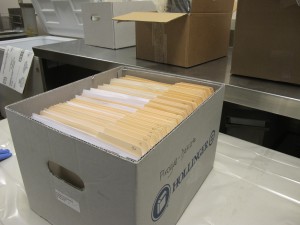Wednesday, March 16, 2016
 With much trepidation yesterday, I went off to work with Tish Boyer at the National Mississippi River Museum & Aquarium in Dubuque to assist her in salvage efforts of significantly damaged photographic negatives. Tish had shared photos of the damaged items ahead of my visit. The sight was not pretty! The negatives had been stored in a refrigerator that quit working some days before staff discovered there was a problem. Some of the emulsion layer on the negatives had turned to liguid and oozed out over the edges of the negatives, making for a gooey mess. I fully expected to just provide moral support as we declared the collection a total loss. Much to our pleasant surprise, we salvaged a lot of the collection! A reinforced lesson that one should never make assumptions about a disaster until there is damage assessment.
With much trepidation yesterday, I went off to work with Tish Boyer at the National Mississippi River Museum & Aquarium in Dubuque to assist her in salvage efforts of significantly damaged photographic negatives. Tish had shared photos of the damaged items ahead of my visit. The sight was not pretty! The negatives had been stored in a refrigerator that quit working some days before staff discovered there was a problem. Some of the emulsion layer on the negatives had turned to liguid and oozed out over the edges of the negatives, making for a gooey mess. I fully expected to just provide moral support as we declared the collection a total loss. Much to our pleasant surprise, we salvaged a lot of the collection! A reinforced lesson that one should never make assumptions about a disaster until there is damage assessment.
 Tish had located a great place to work in within their building. We were able to work in an old kitchen that had a big exhaust fan. It did its job and kept the fumes away. (One of my biggest worries.) We worked with the “best” looking photographic negatives first. This allowed us to establish a work flow and to figure out how to handle the collection. We took photographs of the container or the stack of negatives if no container, before separating out the negatives and interleafing them into groups of 15 and placing into a folder. We kept a log, documenting the package or stack that the negative came from, making note of actual number per folder, and any comments on condition. We learned some tricks. If the stack of negatives got too gooey and seemed to be too stuck together, we turned the stack over and worked from the bottom up. If a stack looked completely “gone”, we looked for an edge within the stack that we could work open and worked from the inside out. It was amazing. Often we would find salvageable negatives within a very gooey, impossible looking group of negatives.
Tish had located a great place to work in within their building. We were able to work in an old kitchen that had a big exhaust fan. It did its job and kept the fumes away. (One of my biggest worries.) We worked with the “best” looking photographic negatives first. This allowed us to establish a work flow and to figure out how to handle the collection. We took photographs of the container or the stack of negatives if no container, before separating out the negatives and interleafing them into groups of 15 and placing into a folder. We kept a log, documenting the package or stack that the negative came from, making note of actual number per folder, and any comments on condition. We learned some tricks. If the stack of negatives got too gooey and seemed to be too stuck together, we turned the stack over and worked from the bottom up. If a stack looked completely “gone”, we looked for an edge within the stack that we could work open and worked from the inside out. It was amazing. Often we would find salvageable negatives within a very gooey, impossible looking group of negatives.
 We worked for 6 hours, separated a little over 1300 negatives with a loss of 250. Not bad considering the state the negatives are in. The salvaged negatives will need additional work. They will need to be cleaned and stabilized. Many have damage around the edges. They will need to be sent off to a photo conservator and then, probably, digitized. The images are a mix of acetate and nitrate film dating around 1925-1932. We didn’t get through the entire collection. Tish has her work cut out for her for the rest of the week. I left her in good spirits. I did accomplish my goal of providing moral support!
We worked for 6 hours, separated a little over 1300 negatives with a loss of 250. Not bad considering the state the negatives are in. The salvaged negatives will need additional work. They will need to be cleaned and stabilized. Many have damage around the edges. They will need to be sent off to a photo conservator and then, probably, digitized. The images are a mix of acetate and nitrate film dating around 1925-1932. We didn’t get through the entire collection. Tish has her work cut out for her for the rest of the week. I left her in good spirits. I did accomplish my goal of providing moral support!
2 thoughts on “Rescuing Photographic Negatives”
Comments are closed.